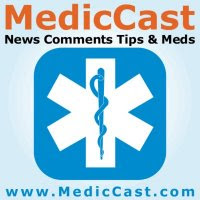
Part II of what I started in Emergency Cardiovascular Care 2010 Update Interview – MedicCast – Part I – At the MedicCast Jamie Davis (the host of MedicCast) and Tom Bouthillet (of Prehospital 12 Lead ECG) interview Dr. Monica Kleinman, incoming Chair of the Emergency Cardiovascular Care committee at the American Heart Association (Heart.org/cpr).
Emergency Cardiovascular Care 2010 Update Interview.
There is a lot to discuss. Everybody does a great job of examining the changes. However, I have some comments on the changes. If you haven’t already, go listen to the show.
–
Dr. Monica Kleinman, incoming Chair of the Emergency Cardiovascular Care committee at the AHA states –
It is hard to make a major change like (eliminating ventilations) without having solid enough evidence that it is superior to what we are doing now. In other words, the fact that there may be a technique that’s just as good is encouraging and is something that we need to consider but the changes to the guidelines need to be made on evidence that shows ‘here’s a better way to do things.
No.
We have found that the evidence for continuing the standard of care is not as solid as we thought it was does not exist.
Where is the evidence that cardiac arrest patients benefit from ventilation?
This is the problem with the approach the AHA (American Heart Association) takes. They are advocating the continuation of unproven treatments. Not just unproven treatments, but treatments that are more invasive and more risky than alternatives supported by better evidence.
Even given two equally beneficial treatments, we should choose the one with less risk, not the one with more evidence. Especially when that evidence is just evidence of less benefit and more side effects.
The evidence that ventilation improves survival does not exist.
Outside of respiratory arrests, the delivery of ventilations only seems to contribute to adverse effects.
Why do we continue with ventilation in spite of a lack of evidence of benefit?
Bias.
Could ventilations worsen outcomes?
There is no could about it, ventilations do lead to complications –
Interruption of, and distraction from, the important task of excellent chest compressions (chest compressions improve survival).
Gastric insufflation leading to vomiting and aspiration of vomit.
Increased pulmonary pressure leading to decreased venous return, in other words interfering with compressions.
General complication of the resuscitation that only increases the chance of mistakes being made.
Here is what the AHA guidelines state –
Passive Oxygen Delivery During CPR
Positive-pressure ventilation has been a mainstay of CPR but recently has come under scrutiny because of the potential for increased intrathoracic pressure to interfere with circulation due to reduced venous return to the heart. In the out-of-hospital setting, passive oxygen delivery via mask with an opened airway during the first 6 minutes of CPR provided by emergency medical services (EMS) personnel was part of a protocol of bundled care interventions (including continuous chest compressions) that resulted in improved survival.6–8 When passive oxygen delivery using a fenestrated tracheal tube (Boussignac tube) during uninterrupted physician-managed CPR was compared with standard CPR, there was no difference in oxygenation, ROSC, or survival to hospital admission.9,10 Chest compressions cause air to be expelled from the chest and oxygen to be drawn into the chest passively due to the elastic recoil of the chest. In theory, because ventilation requirements are lower than normal during cardiac arrest, oxygen supplied by passive delivery is likely to be sufficient for several minutes after onset of cardiac arrest with a patent upper airway.2 At this time there is insufficient evidence to support the removal of ventilations from CPR performed by ACLS providers.[1]
Bold highlighting by the AHA.
In other words –
The experiments must continue until we cannot ignore the evidence of harm any longer.
Without valid research, this is just unprofessional, unethical, uncontrolled, unauthorized, unreasonable experimentation on people who are just too dead to run away. And without any attempt at informed consent.
A perverse result of the new guidelines is that patients will receive better CPR from lay rescuers, assuming the lay rescuers maintain good technique, than they will from professional rescuers – even if the professional rescuers use good technique.
–
Footnotes:
–
[1] Passive Oxygen Delivery During CPR
Part 8: Adult Advanced Cardiovascular Life Support
2010 American Heart Association Guidelines for Cardiopulmonary Resuscitation and Emergency Cardiovascular Care
Part 8.1: Adjuncts for Airway Control and Ventilation
Oxygen During CPR
Free Full Text Article with links to Free Full Text PDF download
.


An interesting thing I found was the AHA found a study that showed prehospital intubation improves survival rates (and strangely enough inhospital worsens it)!
“In out-of-hospital urban and rural settings, patients intubated during resuscitation had a better survival rate than patients who were not intubated,[1] whereas in an in-hospital setting, patients who required intubation during CPR had a worse survival rate.[2]”
I was under the impression the research showed otherwise! Indeed reference Jennings et al [1] only showed an increase in survival to admission but did not state their survival to discharge status by intervention. Additionally they had a survival to discharge rate of 7.1% over the 1 year study period.
In a 2006 study with a smaller sample out of Kansas City, Garza AG [3] found that prehospital ETI was associated with a higher mortality for patients presenting with VF. I tend to believe this study carries a higher weight as their survival to discharge was 19% overall.
1. Jennings PA, Cameron P, Walker T, Bernard S, Smith K. Out-of-hospital cardiac arrest in Victoria: rural and urban outcomes. Med J Aust. 2006;185:135–139.
2. Dumot JA, Burval DJ, Sprung J, Waters JH, Mraovic B, Karafa MT, Mascha EJ, Bourke DL. Outcome of adult cardiopulmonary resuscitations at a tertiary referral center including results of “limited” resuscitations. Arch Intern Med. 2001;161:1751–1758.
3. Garzaa AG, Grattona MC, McElroya J, Lindholma D. 300: Prehospital Intubation Is Associated with Increased Mortality in Primary Cardiac Arrest Patients with Ventricular Fibrillation. Ann Emerg Med. 2006;48:Suppl 1 pp91.